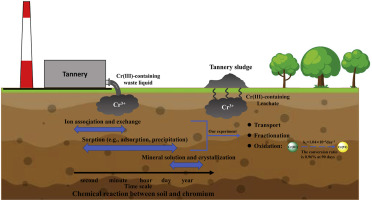Ecotoxicology and Environmental Safety ( IF 6.2 ) Pub Date : 2020-03-14 , DOI: 10.1016/j.ecoenv.2020.110459 Teng Xu 1 , Feng Nan 2 , Xiaofeng Jiang 1 , Yuling Tang 2 , Yunhang Zeng 2 , Wenhua Zhang 3 , Bi Shi 1

|
This work was conducted to study the effect of soil pH (4.0, 6.0, and 8.0) on the transport, fractionation, and oxidation of trivalent chromium [Cr(III)]. Variation in pH altered soil chemical and mineralogical properties such as zeta potential, cation exchange capacity and redox potential of natural soil. Breakthrough curves and batch sorption experiments coupled with fourier transform infrared spectroscopy (FTIR) and X-ray photoelectron spectroscopy (XPS) analyses demonstrated that the easy mobility of Cr(III) in pH 4.0 soil was dominated by the limited coordination effect. The high retention of Cr(III) in pH 8.0 soil was mainly ascribed to the hydrolysis. Incubation experiments indicated that the proportions of Cr in exchangeable fraction decreased with increasing of soil pH and incubation time, and kinetics analysis revealed that the time dependent transformation was controlled by mass transfer and chemical processes (e.g., hydrolysis, ion association). The XPS confirmed the oxidation of Cr(III) in pH 8.0 soil during the incubation period. Furthermore, the content of toxic hexavalent chromium [Cr(VI)] was positively associated with time and initial concentration of Cr(III) released. These results revealed the hazardousness of Cr(III) in soil contaminated simultaneously by inorganic acid and alkali.
中文翻译:

土壤pH值对铬(III)的迁移,分馏和氧化的影响。
进行这项工作以研究土壤pH(4.0、6.0和8.0)对三价铬[Cr(III)]的运输,分馏和氧化的影响。pH值的变化改变了土壤的化学和矿物学性质,例如天然土壤的zeta电位,阳离子交换能力和氧化还原电位。突破曲线和间歇吸附实验,再结合傅里叶变换红外光谱(FTIR)和X射线光电子能谱(XPS)分析表明,Cr(III)在pH 4.0土壤中的易迁移性受有限的配位作用支配。Cr(III)在pH 8.0土壤中的高保留率主要归因于水解。孵化实验表明,随着土壤pH值和培养时间的增加,可交换部分中Cr的含量降低。动力学分析表明,时间依赖性转化受传质和化学过程(例如水解,离子缔合)控制。XPS证实了在孵育期间pH 8.0的土壤中Cr(III)的氧化。此外,有毒六价铬[Cr(VI)]的含量与时间和释放出的Cr(III)的初始浓度呈正相关。这些结果揭示了Cr(III)在同时被无机酸和碱污染的土壤中的危害性。











































 京公网安备 11010802027423号
京公网安备 11010802027423号